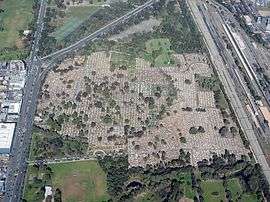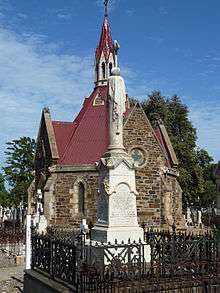West Terrace Cemetery
The West Terrace Cemetery is South Australia's oldest cemetery, first appearing on Colonel William Light's 1837 plan of Adelaide. The 27.6 hectares (68 acres) site is located in Park 23 of the Adelaide Park Lands just south-west of the Adelaide city centre, between West Terrace, Anzac Highway, Sir Donald Bradman Drive and the Seaford and Belair railway lines. Originally known as the Adelaide Public Cemetery, it is divided into a number of sections for various communities and faiths, including two Catholic areas, as well as Jewish, Afghan, Islamic and Quaker sections.
 Aerial view of the West Terrace Cemetery. Also seen are Anzac Highway and West Terrace | |
| Details | |
|---|---|
| Established | before 1837 |
| Location | Adelaide, South Australia |
| Country | Australia |
| Coordinates | 34°56′4″S 138°35′6″E |
| Size | 27.6 hectares (68 acres) |
| No. of interments | >150,000 |
| Website | West Terrace Cemetery (Adelaide Cemeteries Authority) |
| Find a Grave | West Terrace Cemetery |
| Footnotes |
|

History
The Adelaide Park Lands were laid out by Colonel William Light in his design for the city. Originally, Light reserved 2,300 acres for a park, and a further 32 acres (13 ha) for a public cemetery.[1]
Throughout much of its early history the West Terrace Cemetery was plagued with controversy and mismanagement. It was the subject of much public and religious debate and was many times under threat of closure. As early as the 1880s the size of the cemetery was considered insufficient to keep up with demand.
In 1843 the establishment of a Jewish burial area began the distinctive denominational division of the cemetery. In 1845 a Catholic cemetery was established on land adjacent the main public cemetery and in 1849 a third of the public cemetery was given over to the Church of England.[2]
The Smyth Chapel was built in 1871 as a memorial to the Very Reverend Dr John Smyth, Vicar General, who lies buried in the crypt beneath the chapel. It was designed by E. J. Woods in the latter part of 1870 as a result of a competition conducted by the Smyth Memorial Fund and built by Peters and Jones for approximately 472 pounds.
Situated within the Catholic area, the foundation stone was laid on 18 December 1870 by the venerable Archdeacon Russell, Vicar General, and was officially opened and formally consecrated on 22 October 1871.[3]
In 1902, the first crematorium in the southern hemisphere was built and began operating in 1903. For the next 20 years, this was the only crematorium in Australia. A number of famous and important South Australians have been buried in the cemetery and since 2002, the site has been administered by the Adelaide Cemeteries Authority, which also controls a number of other cemeteries within the metropolitan area.
War graves
AIF Cemetery
With concerns from various patriotic associations about soldiers from the First World War without relatives being buried in unmarked graves in the cemetery, a deputation to the Minister of Public Works in February 1920 sought a "Soldiers Lot" not only for these soldiers but also those whose families wished to bury their "soldier loved ones" there. The minister set aside a half an acre of the Light Oval for this purpose, with a monument to be erected by public subscription and soldiers in unmarked graves to be re-interred there.[4] The first burial was in March 1920 but with slow progress of public fund raising the area was not dedicated until Sunday 10 December 1922.[5]
There are buried (at June 2014) 275 Commonwealth service personnel from both World Wars in West Terrace Cemetery whose graves are registered by the Commonwealth War Graves Commission.[6]
Notable interments or cremations
- William and Ann Margaret Bickford, manufacturing chemists
- Arthur Seaforth Blackburn, military officer and Victoria Cross recipient from the First World War
- Abraham Tobias Boas, long serving Rabbi of Adelaide's Jewish congregation
- James Bonnin, London property developer
- Poltpalingada Booboorowie (Tommy Walker), a Ngarrindjeri Aboriginal and popular Adelaide personality in the 1890s
- Charles Campbell, early settler, pastoralist and founder of Campbelltown
- Charles Chewings, geologist and anthropologist
- Sir Dominick Daly, 7th Governor of South Australia
- Phillip Davey, Victoria Cross recipient from the First World War
- J. Matthew Ennis, academic organist and pianist
- Boyle Travers Finniss, settler, soldier, surveyor and the first Premier of South Australia
- Thomas Gilbert, early pioneer and the colony's first Post Master General
- Percy Grainger, international musician and composer
- Charles Beaumont Howard, South Australia's first colonial chaplain
- Reginald Roy Inwood, Victoria Cross recipient from the First World War
- Jorgen Christian Jensen, Danish-born Victoria Cross recipient from the First World War
- Charles Kingston, a Premier of South Australia and a founding member of Australian Federation
- Carl Linger, musician and composer of Song of Australia
- Philip Levi, early settler and pastoralist
- John McPherson, first leader of the South Australian division of the Australian Labor Party
- Frederick Metters, founder of oven and stove manufacturing business that became Metters Limited
- Sir John Morphett (along with other members of his family), early settler, pastoralist and businessman
- Arthur Edward Rossiter, founder of footwear manufacturer, Rossi Boots
- Richard Gilbert Symonds, Surveyor for Colonel Light[7][8]
- Augusta Zadow, female suffragette and early trade unionist
- The unknown victim of the mysterious Taman Shud Case
References
- "The Park Lands". Herald. 6 September 1902. p. 7 – via Trove.
- West Terrace Cemetery History, Adelaide Cemeteries Authority
- Smyth Chapel, Adelaide Cemeteries Authority
- "Deputation to Minister". The Mail. Adelaide. 14 February 1920. p. 2. Retrieved 30 May 2012 – via National Library of Australia.
- "Dedication of the Soldiers' Cemetery". The Advertiser. Adelaide. 9 December 1922. p. 11. Retrieved 30 May 2012 – via National Library of Australia.
- Adelaide (West Terrace) Cemetery, CWGC Cemetery Report.
- Symonds, Richard Gilbert (1810 - 1896) Encyclopedia of Australian Science
- SYMONDS, Richard Gilbert State library – correspondence